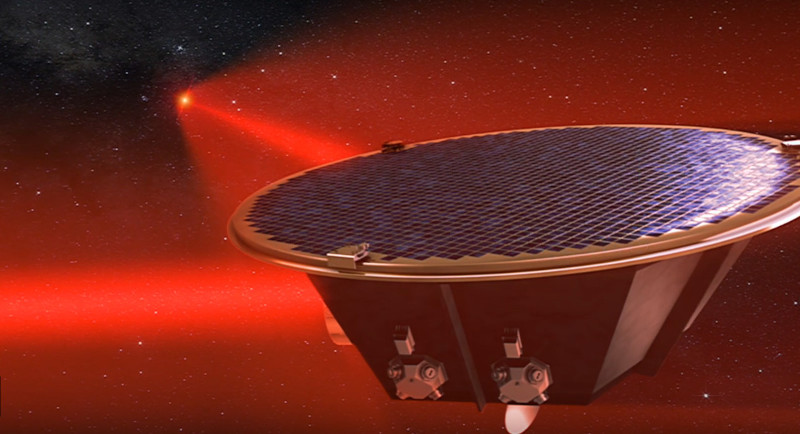
The Laser Interferometer Space Antenna (LISA) is a space mission aiming to detecting gravitational waves, that are tiny ripples in the fabric of spacetime from astronomical sources. LISA consists of 3 satellites, forming a giant interferometer - with 2.5 million km arm length - orbiting the Sun about 20◦ behind the Earth. LISA will target mHz frequencies and binary systems of massive black holes.
The success of the LISA Pathfinder demonstrator in 2016 has paved the way for the flagship mission. The LISA mission has then completed Phase A (industrial study). LISA enters Phase B (industrial production) in 2022 with adoption in 2024 and proceeds to launch around 2034 (nominally), possibly earlier if technical readiness is deemed satisfactory.
APC contributes to the mission scope for fundamental physics (testing General Relativity theory, inferring cosmological parameters, probing the early universe) and astrophysics (identification of formation and evolution channels of GW sources). The team is involved in two major responsibilities: data processing and instrumentation.
LISA Data Processing
The Distributed Data Processing Center (DDPC) is the platform from which the daily LISA data analysis will be performed during (and after) the mission operation. The team is one of the main contributors to the design of the Science Ground Segment and of the infrastructure of the DDPC led by CNES. The common development environment and the DDPC prototype are used by the LISA consortium.
The LISA data analysis is a challenging task that requires the integration of different methods for signal extraction and noise reduction (e.g., laser frequency noise suppression). LISA data are expected to be dominated by gravitational-wave signals. Thousands of sources simultaneously present in the data have to be disentangled.
The main platform for developing and testing data analysis methods is the LISA Data Challenge (LDC, https://lisa-ldc.lal.in2p3.fr/). The LDC working group is in charge of producing the simulated LISA data and developing a set of state-of-the-art data analysis methods, addressing the detection and characterization of all known sources (see below). Tests include robustness against the presence of gaps in the data (due to antenna repointing) and noise artefacts (glitches, long-term non-stationary noise components). This project benefits from the wide range of expertise present in the group, in particular, GW signal modelling from merging black holes and from astrophysical knowledge of the population of GW sources.
LISA Assembly, Integration, Validation and Testing
The contribution proposed by France in the framework of the Assembly, Integration, Validation and Testing (AIVT) focuses on two crucial steps:- The full responsibility for the functional and performance tests of the metrological core of the instrument, named IDS (Interferometric Detection System) and including the optical bench (with its different mounted elements), the signal acquisition system (phasemeter) and the laser source. The IDS is an early development stage to validate the Engineering and then the Qualification models of the instrument components. This step is crucial to globally validate the instrument concept and to reach a level of validation that cannot be achieved with a fully integrated instrument.
- The provision of benches and support for metrological (optical) performance tests of the fully integrated instrument (called MOSA: Movable Sub-Assembly). These tests, extensive on the qualification model and more limited on the 6 flight models (and 2 ’spares’), aim to reproduce some of the IDS level measurements (in order to validate the ’correct’ integration of the instrument) as well as to carry out a set of calibrations and alignment corrections.
Links
- LISA website: http://www.elisascience.org/
- LISAPathfinder website: http://www.elisascience.org/articles/lisa-pathfinder/lpf-mission
- LISAFrance website: http://elisadpc.in2p3.fr/lisafrance/
- eLISA white paper: «The Gravitational Universe»
